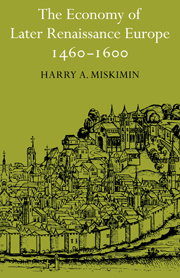Book contents
- Frontmatter
- Contents
- List of tables, graphs, maps
- Dedication
- Preface
- 1 The abstractions of law and property
- 2 Recovery: population and money supply
- 3 Agriculture: the rising demand for food
- 4 Industry: technology and organization
- 5 Trade patterns in the wider world
- 6 Finances: private and public
- 7 Retrospect
- Notes
- Bibliography
- Index
1 - The abstractions of law and property
Published online by Cambridge University Press: 30 September 2009
- Frontmatter
- Contents
- List of tables, graphs, maps
- Dedication
- Preface
- 1 The abstractions of law and property
- 2 Recovery: population and money supply
- 3 Agriculture: the rising demand for food
- 4 Industry: technology and organization
- 5 Trade patterns in the wider world
- 6 Finances: private and public
- 7 Retrospect
- Notes
- Bibliography
- Index
Summary
Witchcraft proliferates when fundamental premises are challenged and society itself appears unstable; it is thus no accident that the later Renaissance witnessed a profusion of witches. By definition, witches are supernatural creatures who exist beyond and in defiance of the laws of nature. They have the capacity to alter regular and expected patterns, to affect the cycles of fertility and regeneration, and to assume unnatural forms and powers. So long as witches are present, the homogeneity of experience is moot; the value of previous empirical observation is dubious; and the possibility of creating rational, scientific hypotheses on the basis of an orderly and immutable set of natural laws is questionable. Witchcraft, then, perhaps unfortunately, is antithetical to the more mundane craft of the modern economist. The latter conceives of the world as regular, bound by his version of natural laws – as, for example, those of supply and demand – and subject to innumerable constraints that enable him to predict, or at least rationally believe that he can predict, the reaction that will be caused by a given action.
Anomalous as it may appear to contrast modern economic thought with witchcraft, the contrast is illuminating. Those who concerned themselves with economic problems in the sixteenth century, particularly those cast as political figures or advisers, often seem to the modern critic to be naive or simply wrongheaded. One wonders, for example, how a thinker of Jean Bodin's genius could invent the quantity theory of money in 1568 and shortly thereafter, in 1576, advocate the most sterile policies of bullionist mercantilism.
- Type
- Chapter
- Information
- The Economy of Later Renaissance Europe 1460–1600 , pp. 1 - 19Publisher: Cambridge University PressPrint publication year: 1975



